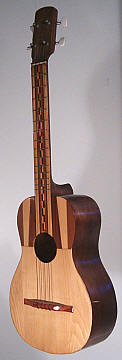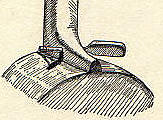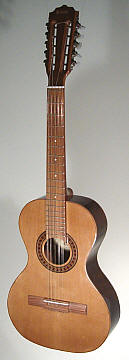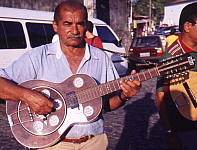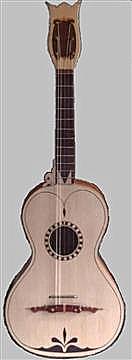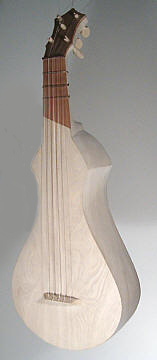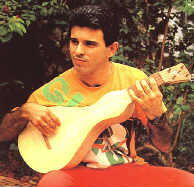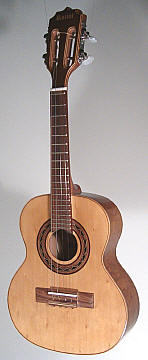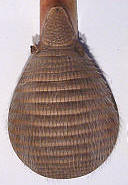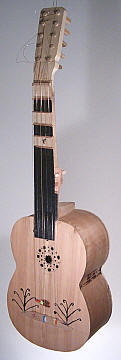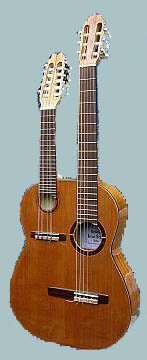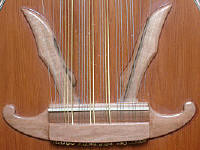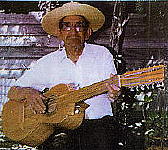| South America | ATLAS of Plucked Instruments |
•
HOME
|
South America This page contains most countries of South
America : For the other countries of America see : Central America/Caribbean or North America. Remember that many instruments are played all over the continent (not just in the countries I have put them here), and because they are locally made, you may find quite a lot of variety in shape and even in the number of strings.
|
| top | Venezuela | |||||||||||||||||||||||||
|
cuatro
The cuatro is the national instrument of Venezuela,
and of course it is so called because it has 4 strings. Other names
are : guitarra pequeña, guitarrita, guitarilla. In Venezuela there are two different kind of cuatro,
used and produced in different parts of the country : The cuatro is made like a small guitar, with a flat back. The top of the front (above the middle of the soundhole) is protected by a thin layer of darker wood. The fingerboard is flush with the front and has metal frets. The length of the neck is depending on the number of frets : 14, 15 (the usual number), 17, 19 or 22 frets. There are no frets on the front. So while the scale increases, the body keeps the same size. The tuning head is either a flat peghead (on the cheaper models), with 2x2 tuning machines from the back, or (now more standard) like a guitar : a double slotted open peghead with two tuning machines on both sides. The 4 nylon strings run to a flat bridge (with nut),
which is glued to the front. Playing is strumming chords for accompaniment - often
with a special rhythmic effect, achieved by damping the strings with
a combined action of the palm and nails of the right hand, leaving a
rhythmic dry noise. |
|||||||||||||||||||||||||
| top | ||||||||||||||||||||||||||
|
bandola
llanera The bandola is another Venezuelan instrument, with a typical pear shaped body. It is a melodic instrument. It comes in two different types : the bandola llanera ("from the plains") and the bandola oriental (see under). The last one can be further divided in the bandola central and the bandola guayanese. These bandolas are also used in some areas of Colombia. The bandola llanera (with 4 single strings) is the most popular. It is made like a guitar, with a flat back, and the top half of the body running almost parallel to the neck. The top of the front (from above half the round soundhole) has often a layer of darker veneer (like the cuatro). The fingerboard is slightly raised above the front, and has metal frets. The flat tuning head has 2x2 tuning machines. The 4 nylon strings run to a glued bridge on the front. The 4 nylon strings are often tuned : a d' a' e". It is usually played with a plectrum.
In Colombia exists an instrument which is also called a bandola (see further on), but which is a type of bandurria, with many strings. In Venezuela this instrument is called bandola andina. |
|||||||||||||||||||||||||
| top | ||||||||||||||||||||||||||
|
bandola
oriental The bandola oriental is often quite similar to the bandola llanera. However the number of strings is different : it has 4 double strings (like a mandolin). This type of instrument is further divided in a bandola central and a bandola guayanese - called after the different regions where they are played. These two usually have metal strings, while in the pure "oriental" (the east) they prefer nylon strings. In some regions slightly different body versions exist, like the example : with a square body top and a smaller extra soundhole, and with the 4 double courses made of nylon. The entire instrument is painted brown. The tuning of the bandola oriental is often
like a mandolin : gg d'd' a'a' e"e" , but many different tunings
are in use. Playing is the style of Jorope, a kind of rhythmic form in 6/8, which is different in the three different regions.
|
|||||||||||||||||||||||||
| top | ||||||||||||||||||||||||||
|
seis
and cinco
Besides the cuatro and bandola Venezuela has another type of small guitar, with different numbers of strings - the first number (in Spanish name) gives the total number of strings, and the second number gives the number of courses : cinco cuatro / cinco / seis cinco /seis / cinco y medio. They are all of the type "monterol", with a
narrow bridge over the full width of the front. These instruments are
made like a normal small guitar, with a flat back. However
the back and the front sticks a few mm over the side. The neck has a
fingerboard, slightly higher than the front, with metal frets. The arrangement and number of strings gives the instrument its name :
These instruments are popular in the area of Llana, but I am told that the "y medio" type is now rather out of fashion (see under). For lots of information about Venezuelan cuatros and family see Cuatro (in Spanish). The example instrument is a seis cinco
: the 4th course is double (in octaves). |
|||||||||||||||||||||||||
| top | ||||||||||||||||||||||||||
|
cinco y medio A cinco y medio is a slightly smaller type of guitar with a different number of strings : a cinco with five nylon strings, plus a short one ("medio" = half) from the heel of the neck. The instrument itself is made like the cinco and the seis (see above), with the bridge over the full width of the body. The difference in these folk instruments is principaly the size; the instruments are : the sexto (six string) biggest (not on Pacoweb pages); the cinco (smaller than sexto); the medio cinco (smaller than cinco) and the cuatros. This kind of instrument is rarely played anymore, and mainly only in a little region of Lara State, called El Tocuyo. And not even all the time, but mainly during the "Tamunangue", folkloristic music for a traditional religious celebration. The cinco y medio and cuatro y medio are not essential for Tamunangue. There are 2 sizes for the cinco y medio and cuatro y medio : the Sanare ("little town") style (in Pacoweb pages) and the El Tocuyo style. The Sanare style has no double strings and the normal tuning is like an extended cuatro : 5 strings+half. The El Tocuyo cinco y medio has also 5 strings, but with only 4 courses; the lowest is an octaved pair (it is called a requinto on Paco web). Tuning of the Sanara style cinco y medio could
be : e a d f'# b' (e'),
|
|||||||||||||||||||||||||
| top | Brazil | |||||||||||||||||||||||||
|
violão
de sete cordas In Brazil the classical
guitar is very popular, but as they speak Portuguese in Brazil,
they call it violão, like in Portugal. The name guitarra
is also used, but mainly for electric guitars. For guitar-like
instruments with the name viola see further on. To make it easier to use (deeper) bass notes, the addition of a (low) 7th string became popular and now most Brazilian brands of instrument factories (Rozini, Giannini, etc.) make 7-string instruments, known as violão de sete cordas ("guitar with seven strings"). These instruments are the same size as the normal classical guitar, but with 4 tuning machines on the left side of the tuning head, and a wider neck. The 7th string is usually tuned to B', making the tuning
: B' E A d g b e'.
|
|||||||||||||||||||||||||
| top | ||||||||||||||||||||||||||
violas of Brazil The viola is the steel-strung
guitar of Brazil, similar to the violas in Portugal.
It is slightly smaller than a classical guitar, and has five
double metal courses. |
||||||||||||||||||||||||||
|
viola
caipira The viola caipira is made like
a slightly smaller and often slender guitar (looks a bit old
fashioned), with a flat back. The same viola may also be called viola
sertaneja - depending on the region it is used. There exist a dozen different tunings for the viola, but often the tuning is open, for easy playing, like : aA d'D f#'f# aa d'd'. The viola caipira is used in many different styles of Brazilian country music.
Note that on Cape Verde they use a different "viola de dez cordas".
One of the most famous solo players on the viola is Roberto Corrêa, who also wrote some courses for it (in Portuguese). |
|||||||||||||||||||||||||
| top | ||||||||||||||||||||||||||
|
viola
nordestina The viola nordestina is the viola, used in the NE of Brasil. It is usually similar in appearance as the viola caipira, so it has (like all violas) 5 double metal courses and is slightly smaller than a guitar. It is there also known as viola sertaneja - after the country music style it is often used for. But in this area also another type of viola is popular : the viola dinamica. This viola ("Dinamica") is a specific Brazilian kind of resonator guitar, originally developed and made by the Brazilian guitar factory of DelVecchio, separate from the dobros and triolians in USA. See the details of the guitar-type Dinamica on the steelguitar page. After DelVecchio stopped production, the Brazilian factory Rozini for some years made a kind of Dinamica-style viola under the name "Viola Vibrante". Nowadays the "dinamica" resonator violas are only custom made by luthiers. There exist dozens of tunings for the viola,
but often the tuning is open, The viola nordestina is mainly used in the Sertaneja music - a kind of Brazilian Country music, played in the North East of Brazil.
|

